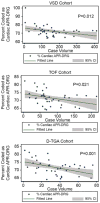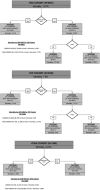Accuracy of the all patient refined diagnosis related groups classification system in congenital heart surgery
- PMID: 24200398
- PMCID: PMC4624088
- DOI: 10.1016/j.athoracsur.2013.08.012
Accuracy of the all patient refined diagnosis related groups classification system in congenital heart surgery
Abstract
Background: Administrative data are increasingly used to evaluate clinical outcomes and quality of care in pediatric congenital heart surgery (CHS) programs. Several published analyses of large pediatric administrative data sets have relied on the All Patient Refined Diagnosis Related Groups (APR-DRG, version 24) diagnostic classification system. The accuracy of this classification system for patients undergoing CHS is unclear.
Methods: We performed a retrospective cohort study of all 14,098 patients 0 to 5 years of age undergoing any of six selected congenital heart operations, ranging in complexity from isolated closure of a ventricular septal defect to single-ventricle palliation, at 40 tertiary-care pediatric centers in the Pediatric Health Information Systems database between 2007 and 2010. Assigned APR-DRGs (cardiac versus noncardiac) were compared using χ2 or Fisher's exact tests between those patients admitted during the first day of life versus later and between those receiving extracorporeal membrane oxygenation support versus those not. Recursive partitioning was used to assess the greatest determinants of APR-DRG type in the model.
Results: Every patient admitted on day 1 of life was assigned to a noncardiac APR-DRG (p<0.001 for each procedure). Similarly, use of extracorporeal membrane oxygenation was highly associated with misclassification of CHS patients into a noncardiac APR-DRG (p<0.001 for each procedure). Cases misclassified into a noncardiac APR-DRG experienced a significantly increased mortality (p<0.001).
Conclusions: In classifying patients undergoing CHS, APR-DRG coding has systematic misclassifications, which may result in inaccurate reporting of CHS case volumes and mortality.
Keywords: 20; 21; 4; APR-DRG; All Patient Refined Diagnosis Related Groups; CHS; D-TGA; DOL1; ECMO; HLHS; ICD-9-CM; PHIS; Pediatric Hospital Information Systems; TOF; VSD; congenital heart surgery; d-transposition of the great arteries, with or without VSD; day of life 1 admission; extracorporeal membrane support oxygenation; hypoplastic left heart syndrome; tetralogy of Fallot; using International Classification of Diseases, 9th Revision, Clinical Modification; ventricular septal defect.
Copyright © 2014 The Society of Thoracic Surgeons. Published by Elsevier Inc. All rights reserved.
Figures







References
-
- Pediatric Cardiac Surgery Steering Committee, National Voluntary Consensus Standards For Pediatric Cardiac Surgery: A Consensus Report. [Accessed March 2012];2011 Available at http://www.qualityforum.org/Publications/2011/12/National_Voluntary_Cons....
-
- Bolsin S, Barach P. The role and influence of public reporting of pediatric cardiac care outcome data. Progress in Pediatric Cardiology. 2012;33(1):99–101.
-
- Elliott MJ. The role of information in ensuring quality and patient safety. Progress in Pediatric Cardiology. 2012;33(1):5–10.
-
- Jacobs JP, Jacobs ML, Lacour-Gayet FG, et al. Stratification of complexity improves the utility and accuracy of outcomes analysis in a Multi-Institutional Congenital Heart Surgery Database: Application of the Risk Adjustment in Congenital Heart Surgery (RACHS-1) and Aristotle Systems in the Society of Thoracic Surgeons (STS) Congenital Heart Surgery Database. Pediatr Cardiol. 2009;30(8):1117–30. - PubMed
-
- Shanian DM, SilversteinT, Lovett AF, Wolf RE, Normand SL. Comparison of clinical and adminstrative data soures for hospital coronary artery bypass graft surgery report cards. Circulation. 2007;155:1518–27. - PubMed
Publication types
MeSH terms
Grants and funding
LinkOut - more resources
Full Text Sources
Other Literature Sources
Medical
Miscellaneous

